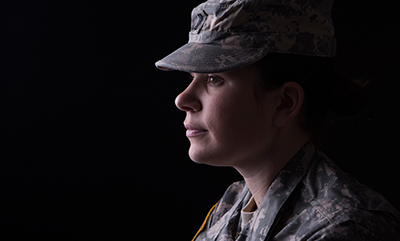Female Reserve Officers Have Higher Rates of PTSD and Depression.
 Women officers in the US Reserve may be at greater risk for post-traumatic stress disorder (PTSD) and depression when compared to their male and enlisted counterparts, according to a study co-authored by School of Public Health researchers that has been selected as an “Editor’s Choice” article in the latest issue of the journal Women’s Health Issues.
Women officers in the US Reserve may be at greater risk for post-traumatic stress disorder (PTSD) and depression when compared to their male and enlisted counterparts, according to a study co-authored by School of Public Health researchers that has been selected as an “Editor’s Choice” article in the latest issue of the journal Women’s Health Issues.
In the study, a research team led by Gregory Herschel Cohen, a statistical analyst in epidemiology, analyzed phone-interview responses from 1,024 members of the US Reserve Component (including the Air Force, Army, Marine Corps, Navy, and National Guard Air Force and Army) who had been deployed. Participants responded to questions about PTSD related to their most recent deployment, and depression since their most recent deployment. From the responses, the authors assessed whether the participants met criteria for PTSD and/or depression.
When comparing all women to all men, the authors found women had a greater prevalence of PTSD (8.5 percent in women versus 7.5 percent in men) and a lower prevalence of depression (12.2 percent in women versus 13.7 percent in men). However, when considering rank, they found that women officers were approximately five times more likely than enlisted women to have PTSD symptoms (21 percent versus 5 percent). Female officers were also at greatest risk for depression, followed by enlisted men, enlisted women, and male officers.
The research team suggested several possible explanations for their findings, including that female officers have different support structures or less organizational control than their male officers, or that the challenges associated with Reserve Component service (such as family disruptions during deployment) are especially intense for women holding officer ranks.
They cautioned that the small number of women in the sample who met the criteria for PTSD or depression means that the findings should be treated as preliminary and warrant further investigation.
“Future research should not only test the findings, but determine the causes of this disparity and ways to mitigate it,” Cohen said.
SPH co-authors on the study include Dean Sandro Galea, Robert A. Knox professor, and Laura Sampson, a statistical analyst in epidemiology. Other authors are from the Mailman School of Public Health at Columbia University and the Center for the Study of Traumatic Stress, Hebert School of Medicine, Uniformed Services University of the Health Sciences.